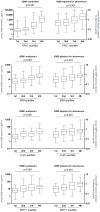Urinary vitamin D binding protein: a potential novel marker of renal interstitial inflammation and fibrosis
- PMID: 23409077
- PMCID: PMC3569442
- DOI: 10.1371/journal.pone.0055887
Urinary vitamin D binding protein: a potential novel marker of renal interstitial inflammation and fibrosis
Abstract
Non-invasive tubulointerstitial damage markers may allow better titration and monitoring of renoprotective therapy. We investigated the value of urinary vitamin D binding protein excretion (uVDBP) as a tubulointerstitial inflammation and fibrosis marker in adriamycin rats, and tested whether uVDBP parallels renal damage and responds to therapy intensification in humans. In adriamycin (ADR) rats, uVDBP was strongly elevated vs controls (CON) already 6 wks after nephrosis induction (ADR: 727±674 [mean±SD] vs CON: 9±12 µg/d, p<0.01), i.e. before onset of pre-fibrotic and inflammatory tubulointerstitial damage, and at all following 6-wk time points until end of follow up at 30 wks (ADR: 1403±1026 vs CON: 206±132 µg/d, p<0.01). In multivariate regression analysis, uVDBP was associated with tubulointerstitial macrophage accumulation (standardized beta = 0.47, p = 0.01) and collagen III expression (standardized beta = 0.44, p = 0.02) independently of albuminuria. In humans, uVDBP was increased in 100 microalbuminuric subjects (44±93 µg/d) and in 47 CKD patients with overt proteinuria (9.2±13.0 mg/d) compared to 100 normoalbuminuric subjects (12±12 µg/d, p<0.001). In CKD patients, uVDBP responded to intensification of renoprotective therapy (ACEi+liberal sodium: 9.2±13.0 mg/d vs dual RAAS blockade+low sodium: 2747±4013, p<0.001), but remained still >100-fold increased during maximal therapy vs normoalbuminurics (p<0.001), consistent with persisting tubulointerstitial damage. UVDBP was associated with tubular and inflammatory damage markers KIM-1 (standardized beta = 0.52, p<0.001), beta-2-microglobuline (st.beta = 0.45, p<0.001), cystatin C (st.beta = 0.40, p<0.001), MCP-1 (st.beta = 0.31, p<0.001) and NGAL (st.beta = 0.20, p = 0.005), independently of albuminuria. UVDBP may be a novel urinary biomarker of tubulointerstitial damage. Prospectively designed studies are required to validate our findings and confirm its relevance in the clinical setting.
Conflict of interest statement
Figures




Similar articles
-
Urinary monocyte chemoattractant protein-1 and vitamin D-binding protein as biomarkers for early detection of diabetic nephropathy in type 2 diabetes mellitus.Mol Cell Biochem. 2015 Oct;408(1-2):25-35. doi: 10.1007/s11010-015-2479-y. Epub 2015 Jun 24. Mol Cell Biochem. 2015. PMID: 26104579
-
Reduction of proteinuria in adriamycin-induced nephropathy is associated with reduction of renal kidney injury molecule (Kim-1) over time.Am J Physiol Renal Physiol. 2009 May;296(5):F1136-45. doi: 10.1152/ajprenal.00541.2007. Epub 2009 Feb 18. Am J Physiol Renal Physiol. 2009. PMID: 19225054 Free PMC article.
-
Correlation between urine vitamin D-binding protein and early-stage renal damage in Type 2 diabetes.Zhong Nan Da Xue Xue Bao Yi Xue Ban. 2023 Jan 28;48(1):40-48. doi: 10.11817/j.issn.1672-7347.2023.210701. Zhong Nan Da Xue Xue Bao Yi Xue Ban. 2023. PMID: 36935176 Free PMC article. Chinese, English.
-
Spread of glomerular to tubulointerstitial disease with a focus on proteinuria.Ann Anat. 2010 May 20;192(3):125-32. doi: 10.1016/j.aanat.2010.03.003. Epub 2010 Apr 3. Ann Anat. 2010. PMID: 20400279 Review.
-
[The role of tubulointerstitial changes in progression of kidney function failure in patients with chronic glomerulonephritis (GN)].Przegl Lek. 1996;53(5):443-53. Przegl Lek. 1996. PMID: 8754411 Review. Polish.
Cited by
-
Multi-organ transcriptome atlas of a mouse model of relative energy deficiency in sport.Cell Metab. 2024 Sep 3;36(9):2015-2037.e6. doi: 10.1016/j.cmet.2024.08.001. Cell Metab. 2024. PMID: 39232281
-
Association of VDR-FokI and VDBP-Thr420Lys polymorphisms with cervical spondylotic myelopathy: A case-control study in the population of China.J Clin Lab Anal. 2019 Feb;33(2):e22669. doi: 10.1002/jcla.22669. Epub 2018 Nov 21. J Clin Lab Anal. 2019. PMID: 30461062 Free PMC article.
-
Urinary retinol binding protein is a marker of the extent of interstitial kidney fibrosis.PLoS One. 2014 Jan 8;9(1):e84708. doi: 10.1371/journal.pone.0084708. eCollection 2014. PLoS One. 2014. PMID: 24416268 Free PMC article.
-
Vitamin D inhibits lymphangiogenesis through VDR-dependent mechanisms.Sci Rep. 2017 Mar 17;7:44403. doi: 10.1038/srep44403. Sci Rep. 2017. PMID: 28303937 Free PMC article.
-
Urinary Proteomic Shifts over Time and Their Associations with eGFR Decline in Chronic Kidney Disease.Biomolecules. 2025 Jan 1;15(1):45. doi: 10.3390/biom15010045. Biomolecules. 2025. PMID: 39858440 Free PMC article.
References
-
- Perico N, Cattaneo D, Remuzzi G (2009) Kidney injury molecule 1: In search of biomarkers of chronic tubulointerstitial damage and disease progression. Am J Kidney Dis 53: 1–4. - PubMed
-
- Verboven C, Rabijns A, De Maeyer M, Van Baelen H, Bouillon R, et al. (2002) A structural basis for the unique binding features of the human vitamin D-binding protein. Nat Struct Biol 9: 131–136. - PubMed
-
- Nykjaer A, Dragun D, Walther D, Vorum H, Jacobsen C, et al. (1999) An endocytic pathway essential for renal uptake and activation of the steroid 25-(OH) vitamin D3. Cell 96: 507–515. - PubMed
Publication types
MeSH terms
Substances
LinkOut - more resources
Full Text Sources
Other Literature Sources
Research Materials
Miscellaneous

